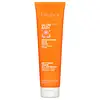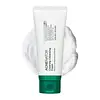What's inside
What's inside
 Key Ingredients
Key Ingredients

 Benefits
Benefits

 Concerns
Concerns

 Ingredients Side-by-side
Ingredients Side-by-side

Water
Skin ConditioningCocamidopropyl Betaine
CleansingSodium Methyl 2-Sulfolaurate
CleansingDisodium 2-Sulfolaurate
CleansingGlycolic Acid
BufferingLactic Acid
BufferingGlycerin
HumectantAloe Barbadensis Leaf Juice
Skin ConditioningMagnesium Ascorbyl Phosphate
AntioxidantMalic Acid
BufferingAllantoin
Skin ConditioningCitric Acid
BufferingSucrose Cocoate
EmulsifyingPotassium Sorbate
PreservativeSodium Riboflavin Phosphate
Skin ConditioningPhenoxyethanol
PreservativeVanilla Planifolia Fruit Extract
Skin ConditioningParfum
MaskingWater, Cocamidopropyl Betaine, Sodium Methyl 2-Sulfolaurate, Disodium 2-Sulfolaurate, Glycolic Acid, Lactic Acid, Glycerin, Aloe Barbadensis Leaf Juice, Magnesium Ascorbyl Phosphate, Malic Acid, Allantoin, Citric Acid, Sucrose Cocoate, Potassium Sorbate, Sodium Riboflavin Phosphate, Phenoxyethanol, Vanilla Planifolia Fruit Extract, Parfum
Glycerin
HumectantLeptospermum Scoparium Leaf Extract
Skin ConditioningWater
Skin ConditioningSodium Cocoyl Glycinate
CleansingSodium Lauroyl Glutamate
1,2-Hexanediol
Skin ConditioningLaminaria Japonica Extract
Skin ProtectingEclipta Prostrata Leaf Extract
Skin ConditioningHamamelis Virginiana Extract
AntiseborrhoeicMelaleuca Alternifolia Leaf Oil
AntioxidantHydrogenated Lecithin
EmulsifyingCoco-Betaine
CleansingSalicylic Acid
MaskingAcrylates/C10-30 Alkyl Acrylate Crosspolymer
Emulsion StabilisingCitric Acid
BufferingBeta-Glucan
Skin ConditioningFructooligosaccharides
HumectantGluconolactone
Skin ConditioningHydrolyzed Hyaluronic Acid
Humectant4-Terpineol
MaskingZinc PCA
HumectantCapryloyl Salicylic Acid
ExfoliatingHydroxyacetophenone
AntioxidantEthylhexylglycerin
Skin ConditioningGlycerin, Leptospermum Scoparium Leaf Extract, Water, Sodium Cocoyl Glycinate, Sodium Lauroyl Glutamate, 1,2-Hexanediol, Laminaria Japonica Extract, Eclipta Prostrata Leaf Extract, Hamamelis Virginiana Extract, Melaleuca Alternifolia Leaf Oil, Hydrogenated Lecithin, Coco-Betaine, Salicylic Acid, Acrylates/C10-30 Alkyl Acrylate Crosspolymer, Citric Acid, Beta-Glucan, Fructooligosaccharides, Gluconolactone, Hydrolyzed Hyaluronic Acid, 4-Terpineol, Zinc PCA, Capryloyl Salicylic Acid, Hydroxyacetophenone, Ethylhexylglycerin
 Reviews
Reviews

Ingredients Explained
These ingredients are found in both products.
Ingredients higher up in an ingredient list are typically present in a larger amount.
Citric Acid is an alpha hydroxy acid (AHA) naturally found in citrus fruits like oranges, lemons, and limes.
Like other AHAs, citric acid can exfoliate skin by breaking down the bonds that hold dead skin cells together. This helps reveal smoother and brighter skin underneath.
However, this exfoliating effect only happens at high concentrations (20%) which can be hard to find in cosmetic products.
Due to this, citric acid is usually included in small amounts as a pH adjuster. This helps keep products slightly more acidic and compatible with skin's natural pH.
In skincare formulas, citric acid can:
While it can provide some skin benefits, research shows lactic acid and glycolic acid are generally more effective and less irritating exfoliants.
Most citric acid used in skincare today is made by fermenting sugars (usually from molasses). This synthetic version is identical to the natural citrus form but easier to stabilize and use in formulations.
Read more about some other popular AHA's here:
Learn more about Citric AcidGlycerin is already naturally found in your skin. It helps moisturize and protect your skin.
A study from 2016 found glycerin to be more effective as a humectant than AHAs and hyaluronic acid.
As a humectant, it helps the skin stay hydrated by pulling moisture to your skin. The low molecular weight of glycerin allows it to pull moisture into the deeper layers of your skin.
Hydrated skin improves your skin barrier; Your skin barrier helps protect against irritants and bacteria.
Glycerin has also been found to have antimicrobial and antiviral properties. Due to these properties, glycerin is often used in wound and burn treatments.
In cosmetics, glycerin is usually derived from plants such as soybean or palm. However, it can also be sourced from animals, such as tallow or animal fat.
This ingredient is organic, colorless, odorless, and non-toxic.
Glycerin is the name for this ingredient in American English. British English uses Glycerol/Glycerine.
Learn more about GlycerinWater. It's the most common cosmetic ingredient of all. You'll usually see it at the top of ingredient lists, meaning that it makes up the largest part of the product.
So why is it so popular? Water most often acts as a solvent - this means that it helps dissolve other ingredients into the formulation.
You'll also recognize water as that liquid we all need to stay alive. If you see this, drink a glass of water. Stay hydrated!
Learn more about Water